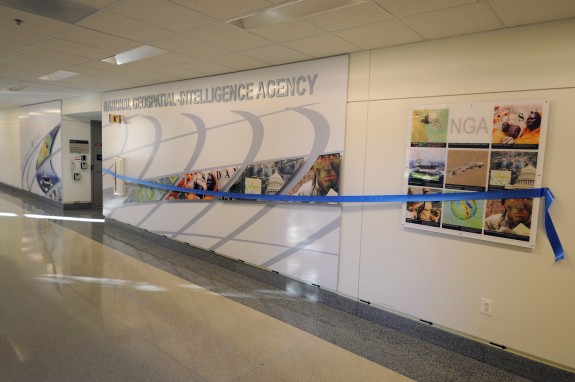
Every graphics project is ultimately about solving a communications challenge. Sometimes it’s as simple as identifying Joe’s Bar and Grill, while other times the message is far more complex. Moreover, while design is the foundation of effective communication, there are other factors that contribute to and complement the design to create a cohesive and consistent message, such as material selection and the right media mix.
Capitol Exhibit Services, based in Manassas, Va., successfully tackled just such a challenge at the National Geospatial-Intelligence Agency’s office in the Pentagon. The challenge in this case was taking a number of design elements and creating a wall-length exhibit that would illustrate the support and services the agency provides to the U.S. military: Humanitarian support; disaster relief and recovery programs; intelligence, surveillance and reconnaissance; global positioning systems; homeland security, support for America’s war fighters; and navigation safety.
The original design called for an anchoring graphic middle panel with a metallic vinyl as the background, an informational panel on one side and a continuation of the graphic panel on the other. Capitol Exhibit Services decided that the more effective print medium for the graphic panels would be LexJet’s Sunset Photo Metallic Paper.
“We were looking for an alternative to metallic vinyl that would still give the graphic an extra shine so I called Jaimie Mask at LexJet for some alternatives and she suggested that we try the Sunset Photo Metallic Paper. Jaimie is a wealth of information and a very good person to have on the phone when we need help finding the latest materials,” says Barney Gault, manager of graphic design and production for Capitol Exhibit Services. “It’s a beautiful paper; it looks just like the Kodak Endura I used to work with in a previous life. Instead of a metallic background, most of it is white, but even the white has a pearlescent shine to it with this paper.”
The graphic was printed on the company’s HP 5500 in about 12 panels, each of which was 40 inches wide and eight feet long (applied vertically). “It worked beautifully. It’s a heavy paper, so instead of wrapping it around the edges like we normally do, we flush mounted the paper and wrapped the laminate around the edges.”
Dimensional letters painted silver cap off the top of the main panel. The secondary panel that details the support and services provided by the National Geospatial-Intelligence Agency was printed on LexJet 8 Mil Ultra Photo Satin Extra and applied second-surface to 1/4-in. plexiglass on stainless steel standoffs.
“I’ve used the Sunset Photo Metallic Paper for a lot of second-surface applications. It’s a great look because you get the depth of the plexi and the shine of the paper. However, one of the prints was larger than 44 inches so I couldn’t use the Sunset Metallic. If I was going to use it on one panel I needed to use it on all of them for that particular piece,” says Gault.
